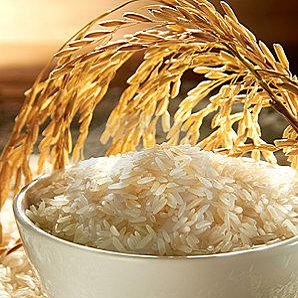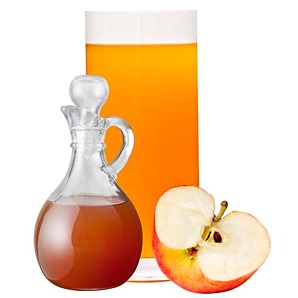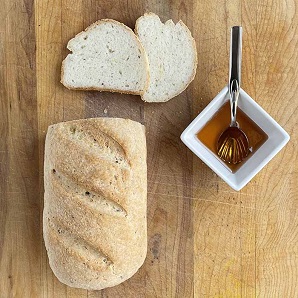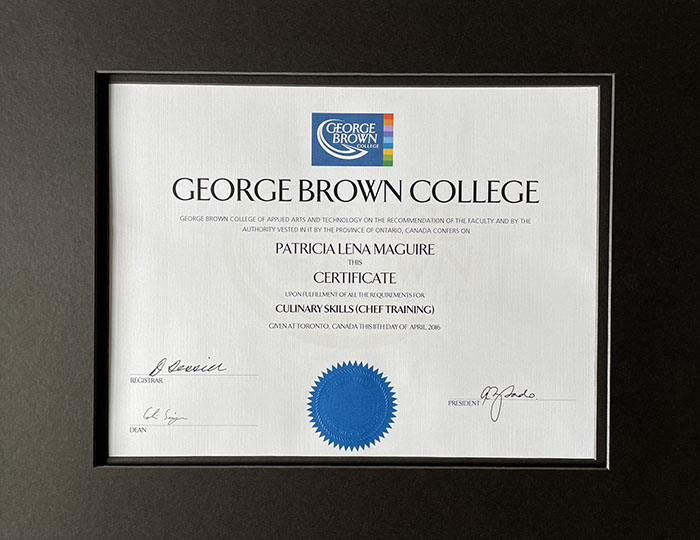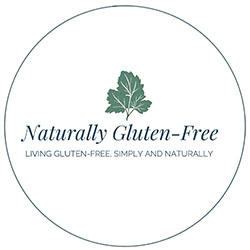- Home
- Gluten Free Kitchen
How to Set Up Your Gluten Free Kitchen for Safe and Easy Cooking
Your gluten-free kitchen really is the center of the universe isn't it? This is where gluten-free cooking happens. It's also where all the food is and all the chaos is. It's a minefield of bread crumbs and sticky pasta pots and you're wondering how you're going to make gluten-free food that's safe and actually gluten-free.
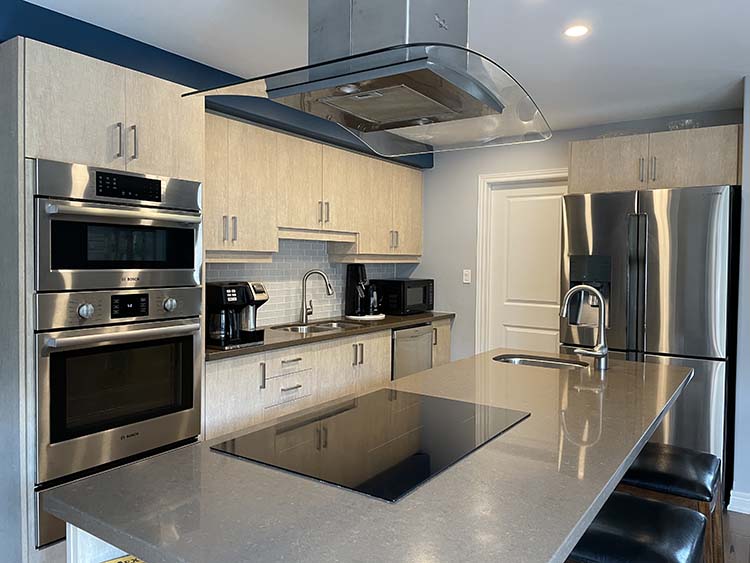
Do You Need a Separate Kitchen for Gluten-Free Food?
It's really up to you to decide based on your own risk tolerance. Some people opt for a completely gluten-free kitchen. They are just too anxious to have any gluten near their food. For most of us though, this isn't necessary.
Here are the three main approaches I see along with some of the pros and cons:
1. The Mostly Gluten Kitchen
"This is my problem and I'm not going to inconvenience the rest of the family"
This is often where people start out. They're newly diagnosed and are starting to understand how big of a change going gluten-free will be. So they decide to take it all on themselves and expect no concessions from the rest of the family.
This usually means the kitchen and pantry stay the same but they carve out a little shelf space for their gluten-free food.
They make everyone else's meals then make their own gluten-free meal separately.
Recognizing the danger of cross contamination they may create a special place for themselves to prepare their gluten-free meals.
This "take it all on myself approach" rarely works because:
- Having to cook separate meals every day is exhausting.
- Keeping your spot clean and safe while the family is spreading around bread crumbs and pasta goop is exhausting.
- You feel different and left out because you're never really sharing a meal with your family.
- If you're the one preparing meals, having to cook food that you can't eat and watching others eat it every day is exhausting and demoralizing.
- You're likely to get sick often from cross contamination and that's exhausting.
2. The Completely Gluten-Free Kitchen
"I have an illness and my family needs to support me. There will be no gluten in my home."
This is certainly the easiest and least risky for you, the person with celiac, and a lot of people do it this way.
If you can convince your family to eat gluten-free bread and other gluten-free products and to give up all their favorite treats, then this may be the right solution and you have an amazing family. I wonder if they might be a little resentful when you're not looking though?
Seriously, a lot of people make this work but in my opinion there are some issues.
- Gluten-free bread isn't great and the family won't be happy to eat it if they don't have to.
- Gluten-free processed products are higher in sugar, carbs and calories than their gluten counterparts.
- Gluten-free food is expensive.
- If you have teens it may be impossible to get them to go along.
3. The Mostly Gluten-Free Shared Kitchen
"Let's find a balance that keeps everyone happy and healthy"
I think this is where most people end up and it's how we do it in our home.
Most of the food we cook is naturally gluten-free. This means lots of fresh vegetables, whole fresh cuts of meat and other naturally gluten-free staples like beans, rice, and gluten-free pasta. Everyone eats this stuff.
How Do Celiacs Share Kitchens?
It's all about keeping things organized and preventing cross contamination:
- in the pantry, fridge and freezer
- during food prep
- during cooking
- while serving the meal
- during clean up
You'll need to make some changes to how you prepare and cook your food. You may need some new equipment too. But don't go overboard, there are just a few key things you'll need to keep separate.
Setting Up Your Gluten-Free Pantry
Instead of a little bit of shelf space carved out for gluten-free food, it will probably be the other way around. Most of the food will be naturally gluten-free and there will be a little bit of space for gluten treats. Here are a few more tips:
- Have a bread box for bread and buns.
- Have a spot on the shelf for cereal, crackers and granola bars. Keep everything in it's original packaging and tightly sealed.
- I suggest all sauces, soups and condiments be gluten-free unless someone has a favorite that they can't live without.
- Teach the family not to double dip and to clean up after themselves. Mine know how important it is to keep Mom's kitchen gluten free, so we have very few problems. It took some training though.
- Use squeeze bottles for condiments.
- Keep your own jam and peanut butter away from the family if double dipping is a problem.
Before you go any further, you'll need to go through your pantry. Do a good clear out, then restock with all the gluten-free staples you're going to need.
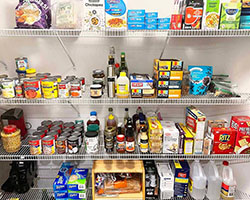
Step by step guide to going through your pantry and figuring out:
- what's gluten-free and what's not
- what to keep and what to let go
- how to clean and re-organize
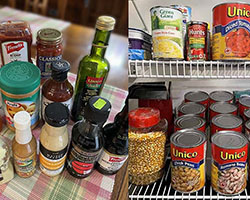
All the essential items you'll need for simple and safe gluten-free cooking and baking.
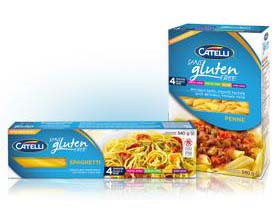
This list of 30 things that contain gluten and what you can eat instead, will help you to re-stock your pantry and refrigerator with safe, delicious gluten-free food.
Preventing Cross Contamination in Your GF Kitchen
What is Cross Contamination?
Gluten cross contamination or cross contact are the same thing. It's what happens when a food or ingredient with gluten accidently comes in contact with a gluten-free food making it potentially unsafe for a person with celiac.
Keep in mind that up to 20ppm (parts per million) or between 10mg and 50mg of gluten per day is considered safe for someone with celiac1.
So you don't have drive yourself crazy trying to eliminate every molecule of gluten, but the goal is to keep it as close to zero as reasonably possible.
Food Prep
It's important that there are no toast crumbs or flour dust or pasta water where you are preparing your gluten free food. Suggestions for dealing with this are:
- Have a separate area to prepare sandwiches and gluten food. Clean up immediately. In our house we use the area right by the toaster.
- We rarely use wheat flour in our house. Flour can stay in the air for up to 24 hours and continue to settle on your work surfaces2. I consider that too risky for my liking.
- Before you start prepping your gluten-free food, give the work surface a wipe and use a clean cutting board.
Pots, Pans, Dishes and Utensils

Does a celiac need separate pot, pans dishes and utensils?
It depends on how easy the item is to clean.
Gluten washes off smooth surfaces with hot soapy water, so items that can be shared are things like:
- pots and pans
- dishes
- glasses
- glass baking dishes
- cutlery
- stone or cast iron cookware that's glazed
Items with lots of texture or grooves can be hard to clean. You may want to consider having dedicated gluten-free versions of the following:
- cutting boards
- colanders or strainers
- plastic utensils, especially if textured or scratched
- wooden utensils
- baking pans that won't come clean*
- stoneware or cast iron that's not glazed
*You can line baking pans with paper liners or parchment.
If someone in your home is cooking wheat pasta, have them wash the pot immediately with hot soapy water and get all the sticky pasta goop off. If you have a dishwasher I suggest running it through after hand washing.
Because pasta is so sticky it does make me a bit nervous. You may want to consider a dedicated pasta pot that you don't cook anything gluten-free in.
Cooking Gluten and Gluten-Free Together
If you're cooking gluten-free and gluten foods together there is opportunity for cross contamination or cross contact. Here are some tips to stay safe.
Cook Gluten-Free First: On the grill, or the pancake griddle, cook gluten-free items first then set aside to keep warm while you're cooking the gluten items
Watch for splash over: On the stove or in the oven, make sure the pots are far enough apart so that liquid from one won't splash into the other. In the oven, have the gluten-free item on top and if possible, covered to protect it from splash over.
Add a Barrier: Grills and pans should be fine if well cleaned, but if you're not comfortable then lining with foil or parchment is a good way to protect yourself.
Keep Stirring Spoons Separate: When stirring items on the stove, keep separate stirring spoons and keep each one close to the dish it's meant for so you don't mix them up.
Serving the Meal
If your meals are mostly naturally gluten-free foods with maybe some bread or buns, this won't be a big problem.
- If you are serving dishes that contain gluten, keep them as far away from the gluten-free food as possible and keep separate serving spoons.
- Make sure everyone knows that serving utensils can't be switched between dishes.
- Be especially vigilant at buffets or dinner parties. Try to get your food first before serving utensils get switched around.
- Watch for people double dipping in the butter.
The Toaster
Okay, we all know what the bottom of the toaster looks like. It's a black hole of evil gluteny bread crumbs down there and you need protection!
There was a study a few years ago where they made gluten-free toast in a toaster that was used for wheat bread and then tested for cross contamination. It turned out in the study that the cross contamination was minimal. But for me and for most people I've talked to, the risk is just too high.
Here are some suggestions:
Have a Separate Toaster:
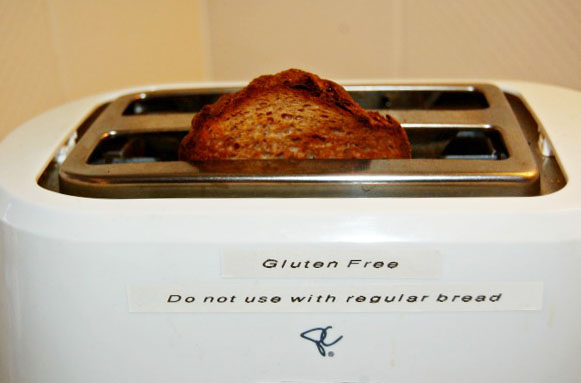
I keep a separate toaster for myself labelled “Gluten Free” and it sits on the opposite side of the counter from the regular toaster.
This way I can be sure my toast is not being contaminated by wheat bread crumbs.
If your gluten free kitchen doesn't have the counter or cupboard space for a second toaster there are some other things you can do.
Opt for a toaster oven
This way everyone can make their toast in the same oven.
You just need to make sure there is a piece of foil or parchment under yours so it doesn't touch the rack. You may need to flip it over and do each side separately.
You can also make toast in the oven. I often do this if I'm travelling or staying in someone else's home where I don't have the luxury of a gluten free toaster and maybe don't have parchment or toaster bags handy. Just do your toast on a piece of foil under the broiler. Keep an eye though or it will burn.
Bag your toast
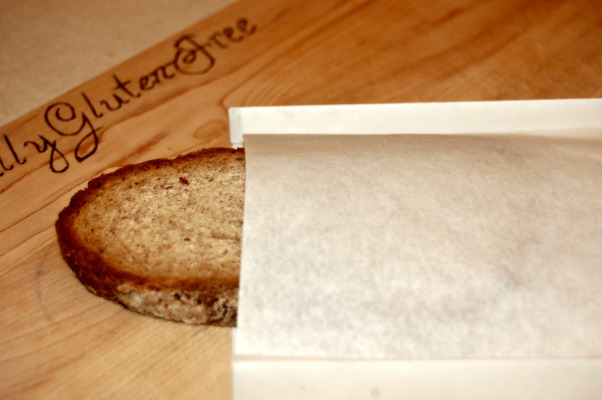
You can buy toaster bags, or make them by folding a piece of parchment in half and then folding in the edges. Then you can put it in the regular toaster
The bag comes out a bit scorched but the toast turns out fine, although it's not as brown or crispy as regular toast.
Keeping Your Gluten-Free Kitchen Clean
We all know that bread crumbs get everywhere. They sneak into the corners of your counter, even into the drawers if you’re not careful. So here is where you need to be almost obsessive and teach your family to be as well.
Counters must be wiped often, especially the area around the toaster. Teach the family to wipe up immediately after making a sandwich. They should use a disposable paper towel or put the cloth or sponge into the laundry immediately. You don’t want to wash your dishes with a gluten soaked sponge!
If the utensil drawer is near where sandwiches are made, be vigilant. I don’t know how it happens. I’ve never actually seen somebody wipe bread crumbs into the cutlery drawer, but somehow they get in there. You need to clean it out often. Do it when most of the cutlery is in the dishwasher.
The dish cloth or kitchen sponge: Change it often! Mine goes to the laundry a minimum of once a day. In perusing the internet, I’ve seen all kinds of complicated systems for washing dishes. One lady said she has four different brushes. I didn’t quite understand how it all worked but she seemed happy with it. In my opinion that’s just too complicated. If you’ve cooked items containing gluten and gluten free items at the same meal, wash the pots and dishes that held the gluteny items last. Change the water if it gets murky. Rinse well in hot water. Throw the cloth into the laundry immediately.
Conclusion
I hope by now your a bit more comfortable with getting your kitchen and pantry set up for gluten-free cooking and baking. Just to recap, here are the highlights:
 |
Decide on the approach that works for you and your family. A shared kitchen with mostly naturally-gluten free meals and a few gluten treats is most common. |
 |
You can safely share a kitchen so long as you're careful about cross-contamination. |
 |
Gluten washes off smooth surfaces with hot soapy water so items like pot, pans, dishes and metal utensils can be shared. |
 |
Gluten is sticky so hard to clean items should be kept separate. |
 |
Guard against cross contamination during cooking. |
 |
Keep your kitchen clean and change your sponge or dish cloth often. |
Home > Gluten-Free Kitchen
Sources:
1. Collin, P., Mäki, M., & Kaukinen, K. (2007, July 1). Safe gluten threshold for patients with celiac disease: Some patients are more tolerant than others. OUP Academic. Retrieved July 23, 2022, from https://academic.oup.com/ajcn/article/86/1/260/4633248?login=false
2. Cross-contact. Beyond Celiac. (2021, February 8). Retrieved October 21, 2022, from https://www.beyondceliac.org/gluten-free-diet/cross-contact/#:~:text=An%20Explanation%3A%20Most%20people%20will,for%20the%20next%2024%20hours.








